![]()
![]()
![]()
Use LEFT and RIGHT arrow keys to navigate between flashcards;
Use UP and DOWN arrow keys to flip the card;
H to show hint;
A reads text to speech;
13 Cards in this Set
- Front
- Back
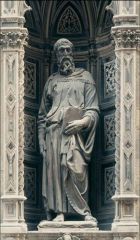
|
Name: Saint Mark, Or San Michele
(Marble, 7’9” high) Artist/Culture: Donatello Early Renaissance Date: 1411-1413 reborn: contraposto Commissioned by the guild of linen drapers Donatello reintroduced contrapposto: as the figure “moves” so does the drapery Contrasts the medieval portal statuary Standing in the middle of the exterior niche suggests the figure is ready to walk out – separating it from the architecture (almost “in-the-round”) |
|
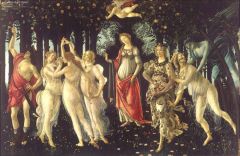
|
Name: La Primavera
(tempera on canvas) Artist/Culture: Botticelli Early Renaissance Date: 1477-78, Medici commission Reborn: mythology Rediscovers Classical mythology – possibly depicts Roman gods and goddesses (Venus, Cupid, Persephone, Mercury, Zephyr) No one has agreed on actual subject. Shows the freshness of an early spring morning Allegory of life beauty and knowledge united by love |
|
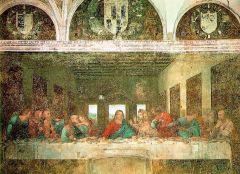
|
Name: The Last Supper
(fresco) Artist/Culture: Leonardo da Vinci High Renaissance Date: 1495-1498 Milan, Italy Reborn: perspective Illusion to a 3D surface Jesus announces that a disciple will betray him Jesus at the center of the pyramid Example of one-point perspective, with everything in the picture pointing to Christ’s head creating pyramid composition Each person reacting to Christ’s announcement that one of them would betray him Considered the most famous religious painting Painted with experimental technique that did not adhere well to the plaster, so it is terribly damaged, but it is being restored |
|
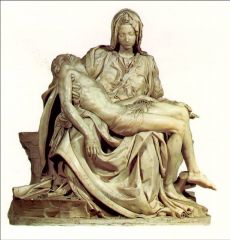
|
Name: La Pietà
(carved marble) Artist/Culture: Michelangelo High Renaissance Date: 1498-1500 Rome Pyramid composition Pietà means pity Pietà means “pity.” Mary holding Jesus – pyramid composition Carved out of one piece of marble. Michelangelo created when he was 23 – he died at 89 Only work he ever signed He studied corpses to learn accurate anatomy. He thought sculpting was the most god-like form of art. |
|

|
Name: The Sistine Chapel
(fresco) Artist/Culture: Michelangelo High Renaissance Date: 1508-1512 The Vatican, Rome Fresco = tempera on plaster Michelangelo was forced by Pope Julius II to paint the chapel’s ceiling. He considered painting an inferior art. There were more than 340 human figures (10’ – 18’ tall) representing the origin and fall of man. |
|
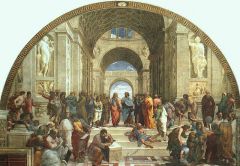
|
Name: The School of Athens
(fresco) Artist/Culture: Raphael High Renaissance Date: 1510-1511 Vatican Museum, Rome Reborn: ancient thinkers, mythology New: Linear Perspective Pagan and christian Pope had them on the wall Law, Theology, Poetry Philosophy Plato and Aristotle Shows Greek philosophers and their students Plato, in red, points to heaven as source of ideas. Aristotle, in blue, points to earth as object of all observations. Socrates, Pythagoras, and Euclid are also shown. Raphael was very popular – died at 37. Uses pyramid and chiaroscuro of Leonardo; and full-bodies, dynamic figures like Michelangelo |
|
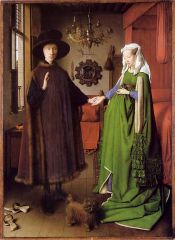
|
Name: The Arnolfini Wedding
(oil on wood) Artist/Culture: Jan van Eyck Northern Renaissance – Flemish Date: 1434 National Gallery, London themes sanctity of marriage dog = fidelity van Eyck trained as a painter of miniatures and illuminated manuscripts Thought to be a form of “wedding certificate'' for Giovanni Arnolfini and Giovanna Cenami, who married in Bruges in 1434 Probably the painter was asked to record this important moment as a witness, just as a notary might be asked to declare that he has been present at a similar solemn act. This would explain why the master has put his name in a prominent position on the picture with the Latin words 'Johannes de eyck fuit hic' (Jan van Eyck was here). Mirror in the background reflects the room – a miniature painting surrounded by scenes from the life of Christ. Symbols (every object represents the sanctity of marriage): Candle – bridal candle or devotional candle Dog – faithfulness and love Fruit on the window ledge – fertility Discarded shoes – sanctity of marriage/holy ground |
|

|
Name: The Garden of Earthly Delights (oil on panel)
Artist/Culture: Hieronymous Bosch Northern Renaissance – Dutch Date: c. 1500 Prado, Madrid, Spain Warns against eroticism disturbing Triptych – three panels plus shutters (altarpiece) Probably made for the enjoyment of a noble family It is named for the luscious garden in the central panel, which is filled with cavorting nudes and giant birds and fruit. “The Garden of Delights” in the center illustrates a world deeply engaged in sinful pleasures. The triptych depicts the history of the world and the progression of sin. Beginning on the outside shutters with the creation of the world, the story progresses from Adam and Eve and original sin on the left panel to the torments of hell, a dark, icy, yet fiery nightmarish vision, on the right. Inspired 20th century Surrealist artists |
|
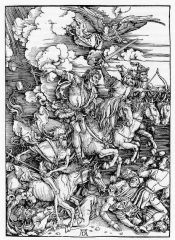
|
Name: The Four Horsemen of the Apocalypse
(woodcut) Artist/Culture: Albrecht Dürer Northern Renaissance – German Date: 1498 war pestilence famine death The “Renaissance Man of the North” and the “Leonardo of the North” for his diversity of interests His vast body of work includes altarpieces and religious works, numerous portraits and self-portraits, woodcuts and copper engravings. First artist to use printmaking as a major medium for art. Used hatching to shade in woodcuts and engraving |
|
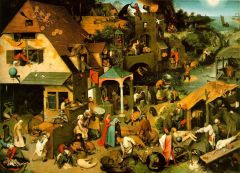
|
Name: The Blue Cloak
(oil on wood) Artist/Culture: Pieter Brueghel Northern Renaissance – Flemish Date: 1599 Staatlich Museen, Berlin Gemaldegalerie Peasant life was his main subject matter – scenes of everyday life, illustrated proverbs, often had a moral. Used atmospheric perspective to show depth – sharp foreground to hazy background This painting illustrates about 100 Flemish proverbs. The title refers to the figure near the center foreground, illustrating the proverb, “She hangs a blue cloak (lies) around her husband.” |
|
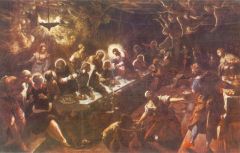
|
Name: The Last Supper
Artist/Culture: Tintoretto (Jacopo Robusti) Mannerism/Late Renaissance Date: 1592-94 San Giorgio Maggiore, Venice Jesus is shining angels are white His nickname derives from his father's profession of dyer (tintore). The church of San Giorgio Maggiore was built on the San Giorgio Island between 1566 and 1600 using the design of Palladio. After 1590 the workshop of Tintoretto was commissioned to paint big canvases for decorating it. Tintoretto painted the Last Supper several times in his life. This version can be described as the feast of the poors, in which the figure of Christ mingles with the crowds of apostles. However, a supernatural scene with winged figures comes into sight by the light around his head. This endows the painting with a visional character clearly differentiating it from paintings of the same subject made by earlier painters like Leonardo. His painting differs from that of the High Renaissance painters: from the traditional frontal representation to this startling diagonally viewed composition more emotional, using vivid exaggerations of light and movement brilliant, rapid notations, bristling with energy, and his color is more somber and mystical |
|
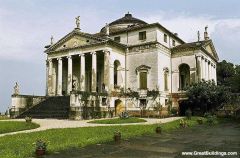
|
Name: Villa Rotunda, located in Vicenza Italy
Artist/Culture: Palladio Renaissance Date: begun in 1550 Greek and roman ionic columns pantheon dome Incorporates Greek and Roman details (Ionic columns, dome like the Pantheon) Palladio wrote Four Books on Architecture – very influential on later architects (Thomas Jefferson – Monticello; Sir Christopher Wren – St. Paul’s Cathedral in London and The College of William and Mary) |
|
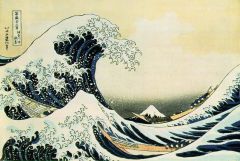
|
The Great Wave at Kanagawa (from a Series of Thirty-Six Views of Mount Fuji)
Katsushika Hokusai (Japanese, 1760–1849); Published by Eijudo Polychrome ink and color on paper contrast between wave and mountain has power wave seems to tower above viewer single moment envisioned in time small pyramid |

